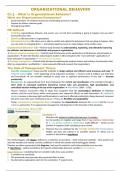Summary
Summary Organizational Behavior - Telfer, uOttawa
- Course
- ADM 2336 (ADM2336)
- Institution
- University Of Ottawa (U Of O )
- What is Organizational Behavior?: What are Organizations/Companies?, OB defined, The Role of Management Theory, ..., How do we know what we know about OB? - Job performance: Task Performance, Citizenship Behavior (OCB), Counterproductive Behavior (CWB), Goal Setting - Organizational Commitment:...
[Show more]



